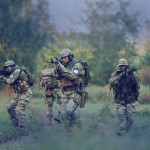If you’ve been paying close attention to the Kravology articles the past several weeks, you may feel we’ve been spending an inordinate amount of time focusing on the fine points of punching and/or combatives to some extent. You may be right. But consider a few things:
This morning there was a focus on the faces of the students who were training my edged weapons flow drill – where one man (in this case) makes a defense and acquires the edged weapon only to immediately utilize the weapon offensively (you might say) against his partner; this process continues back and forth for several minutes per round. During this type of training there is a tension and often a frustration as the drill drags on between the two students – weaknesses are amplified and success becomes measured on a scale not as a singular marker.
Traditionally I notice students, at some point in the drill, become overly focused on the edged weapon and start to physically de-emphasize the combative (counter attack). I stop the drill at this point and make some observations. One major observation can be made for virtually every self-defense technique: the technique simply does not work consistently without a substantial and powerful combative.
A dialogue typically ensues. Issues are raised, considerations are made, but in the end, the truth remains the same – powerful combatives are the very lubrication of the gears of all effective self-defense. The best and most effective combatives are often attacks to the neck (brachial area and throat) and head, where the order to attack is being generated (the attacker’s brain).
Think of this concept as analogous to a machine being run by a computer. If you bang on the machine, it may not function optimally but may still run. However, bang on the computer hard enough, and the machine shuts down completely. This is key to the most relevant issue: something (a combative) must significantly distract or otherwise shut down the brain from issuing violent commands carried out the body.
As I hammer this point home in training, someone invariably asks about the pluck or another movement that may have more technical requirements. The basic question being – isn’t a punch just a punch, like a pluck is a pluck? The answer is no. Consider the binary nature of a pluck. It is a yes/no or pass/fail tactic. Simply, the pluck worked or it didn’t (in the sense that the salient danger was defeated in that moment or it was not). However, landing or not landing a punch is not a binary issue. The issue becomes one of effect on target.
We wouldn’t necessarily wish for a more powerful pluck on the heels of a successful pluck, as the result is the same (either you are being chocked or you are not). One could argue a more powerful pluck creates a more off-balanced attacker, which can be true in some cases, but this misses the point. The point is, the pluck is binary – it achieved an objective or it didn’t.
A punch or combative can really only be seen as “working” when it distracts or shuts down the attacker’s active resistance to your self-defense initiatives. It’s not simply a question of landing (or not landing) a punch.
Let’s take this point back to the example of an edged weapon. By making a block of the initial stabbing motion, the defender has only briefly stopped the incoming attacks (as nothing has been done to make the attackers brain refocus on anything other than the violence he/she wants to achieve). Like a pluck, the initial block of the edged weapon also worked in a self-defense setting. But, more attacks are coming quickly until a combative (counter attack) changes the attacker’s singular, violent focus. At this point, having changed the attackers focus (even briefly), your self-defense initiative now has an opportunity to be completed.
In short, a punch is not just a punch, and a combative is not just a combative. These responses to violent attacks are what create the opportunity for our self-defense techniques to develop into successful defenses.
So, focus on combatives as the critical, common denominator in all your self-defense techniques and training. These combatives really are the “secret sauce” that makes your self-defense techniques so effective.
Note: I make my advanced private students yell, “secret sauce” each time he/she delivers a punch during edged weapons defenses to emphasize and invigorate their efforts. Try it. It works, and it’s fun.
…walk in peace





Arnold
The comparison between a pluck and a punch is especially insightful!